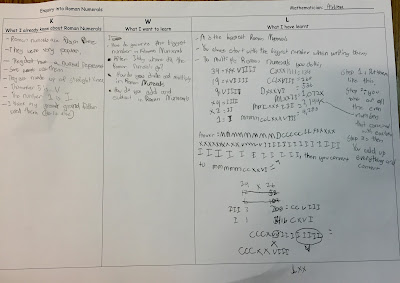We are enquiring into Roman numerals for various reasons:
° They are a number system we still use today on occasion
° Investigating how the Roman numeral system works will help us gain a deeper understanding of our larger maths central idea: Mathematicians saw advantages to creating our Hindu-Arabic number system which extends infinitely in both directions.
° Thinking skills are developed when we will try to work out not only how the place value system works, but how we could add, subtract, multiply and divide Roman numerals
° There is a mathematical link with our migration unit; we are discovering how number systems also migrate just like people. A big understanding is that when people migrate they share ideas, cultures etc
We began with a quick YouTube about Ancient Rome to familiarise us with what we are actually enquiring into.
After that, we looked at our central idea and lines of enquiry we would be exploring in this mini-unit:
Already gaining the understanding that some of us have a lot of knowledge and some not so much about Roman numerals, I figured the good ole KWL chart would be the best strategy to cater to all their different levels of understanding.
We had a few minutes jotting down everything we already knew about Roman numerals. We shared these with our table partners and then together as a class we wrote the numbers 1 to 12 in Roman numerals. I pointed out that I happened to know that originally 4 was written as IIII, but it later changed to IV. The same change occurred with 9.
I hinted there was an important mathematical reason for it needing to be written as IIII and that perhaps some of them might discover this if they start investigating how to add, subtract etc Roman numerals.
Next, we focused on the line of enquiry:
FUNCTION: How does the Roman numerals number system work?
We wrote questions in the 'W' column of things we would like to discover that might help us understand that line of enquiry.
Lots of diverse questions were being generated and I felt I needed to suggest we steer other questions more towards the mathematics of the system at this stage which will help us understand how the system works.
Loads of different questions were generated and I displayed some good examples:
I then gave them a google doc with a list of YoutUbe and website links to help with their enquiries. As they found out, they recorded anything new they learnt in the 'L' column of their KWL chart.
Some of our new discoveries so far:
X is taking her thinking to deeper levels by thinking about how the place value works and comparing it to our Hindu-Arabic system. As she enquires, she keeps adding more questions that she is wondering about. This is a great example of what we should do as enquirers.
X is also taking his learning to deeper levels by challenging himself to solve complicated questions he is posing for himself. This is far more powerful for learning than a teacher simply setting questions for children to answer.
X created her own theory of how the number 49 is written. She found out some key rules to writing numbers in Roman numerals and used that information to try what she thought 49 would look like. Later she found the answer was different to what she had thought. This is a really great example of what we should always do as learners: create our own theories first and then test them out.
At the end of our first day enquiring into Roman numerals, we shared together the most interesting discovery we had each made. These then sparked even more wonderings they wanted to discover tomorrow........





Another great article. Keep up the good work friend.
ReplyDelete